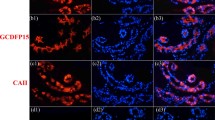Abstract
Studies of sweat glands had demonstrated that there were degenerating cells and proliferating cells in the eccrine sweat glands. To compare the differences in the proliferating cells between human adult and fetal eccrine sweat glands, immunostaining of proliferating-associated proliferating cell nuclear antigen (PCNA) and Ki67 nuclear antigen (Ki67) was performed, and the location and the percentage of the positive staining cells were analyzed. The results showed that a few cells of the secretory and ductal portion in both the adult and fetal eccrine sweat glands stained positive with Ki67 and PCNA. The labeling index of PCNA in adult eccrine sweat glands was 34.71 ± 8.37%, while that in the fetal was 62.72 ± 6.54%. The labeling index of PCNA in fetal eccrine sweat glands was higher than that in adult. Myoepithelial cells were negative staining with anti-PCNA antibody in adult eccrine sweat glands, while in the fetal a few myoepithelial cells were positive staining. Labeling index of Ki67 in adult eccrine sweat glands was similar to that in the fetal, ranging from 0.5 to 4.3%. Myoepithelial cells of the adult and fetal eccrine sweat glands both were negative staining with anti-Ki67 antibody. We concluded that the myoepithelial cells had proliferating ability only in fetal eccrine sweat glands, and that the proliferating ability of fetal eccrine sweat glands was stronger than that of the adult.


Similar content being viewed by others
References
Botticelli AR, Casali AM, Botticelli L et al (1998) Immunohistochemical detection of cell-cycle associated markers on paraffin embedded and formalin fixed needle biopsies of prostate cancer: correlation of p120 protein expression with AgNOR, PCNA/cyclin, Ki-67/MIB1 proliferation-scores and Gleason gradings. Eur J Histochem 42:41–48
Coltrera MD, Gown AM (1991) PCNA/cyclin expression and BrdU uptake define different subpopulations in different cell lines. J Histochem Cytochem 39:23–30
Dang C, Ting K, Soo C et al (2003) Fetal wound healing current perspectives. Clin Plast Surg 30:13–23
Dang CM, Beanes SR, Lee H et al (2003) Scarless fetal wounds are associated with an increased matrix metalloproteinase-to-tissue-derived inhibitor of metalloproteinase ratio. Plast Reconstr Surg 111:2273–2285
Fu XB, Sun TZ, Li XK et al (2005) Morphological and distribution characteristics of sweat glands in hypertrophic scar and their possible effects on sweat gland regeneration. Chin Med J 118:186–191
Li J, Fu X, Sun X et al (2002) The interaction between epidermal growth factor and matrix metalloproteinases induces the development of sweat glands in human fetal skin. J Surg Res 106:258–263
Martin P (1997) Wound healing—aiming for perfect skin regeneration. Science 276:75–81
Sato K, Kang WH, Saga K et al (1989) Biology of sweat glands and their disorders. I. Normal sweat gland function. J Am Acad Dermatol 20:537–563
Schon M, Benwood J, O’Connell-Willstaedt T et al (1999) Human sweat gland myoepithelial cells express a unique set of cytokeratins and reveal the potential for alternative epithelial and mesenchymal differentiation states in culture. J Cell Sci 112:1925–1936
Tsujimura T, Ikeda R, Aiyama S (2006) Changes in the number and distribution of myoepithelial cells in the rat parotid gland during postnatal development. Anat Embryol (Berl) 211:567–574
Yamamoto O, Doi Y, Kudo H et al (2000) Sweat gland toxicity induced by bis (tributyltin) oxide: an ultrastructural and X-ray microanalysis study. Arch Toxicol 74:627–631
Acknowledgments
This work was supported in part by the National Natural Science Foundation of China (30500194) and the National Basic Science and Development Program (973 Program and 2005CB522603).
Author information
Authors and Affiliations
Corresponding author
Additional information
Competing interest statement: The authors declare that they have no competing financial interests.
Rights and permissions
About this article
Cite this article
Li, HH., Fu, XB., Zhang, L. et al. Comparison of proliferating cells between human adult and fetal eccrine sweat glands. Arch Dermatol Res 300, 173–176 (2008). https://doi.org/10.1007/s00403-007-0823-0
Received:
Revised:
Accepted:
Published:
Issue Date:
DOI: https://doi.org/10.1007/s00403-007-0823-0




